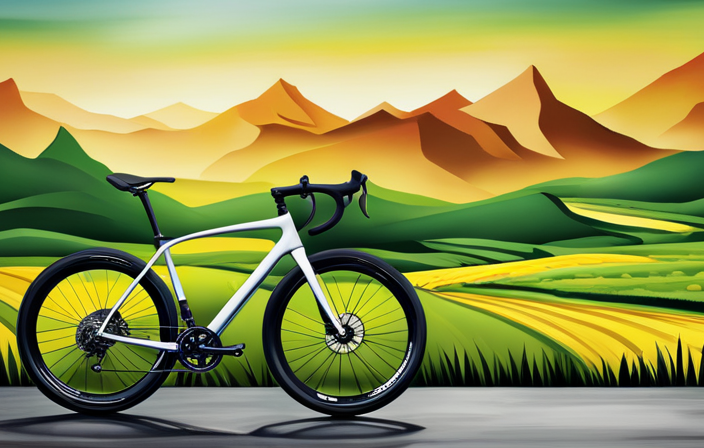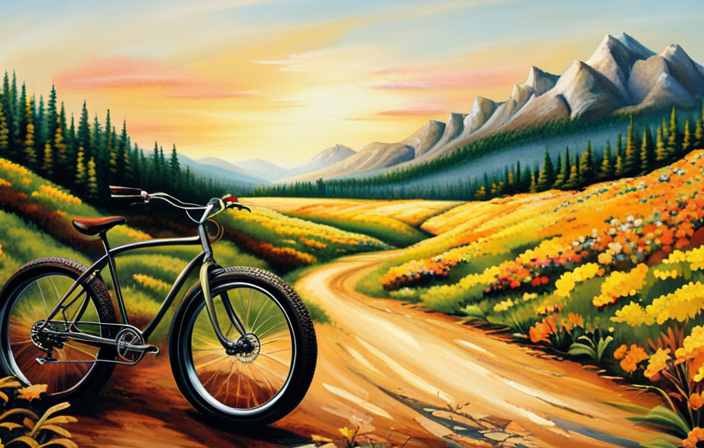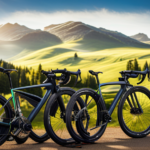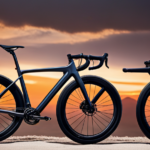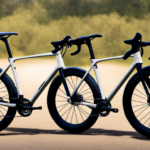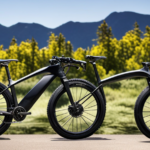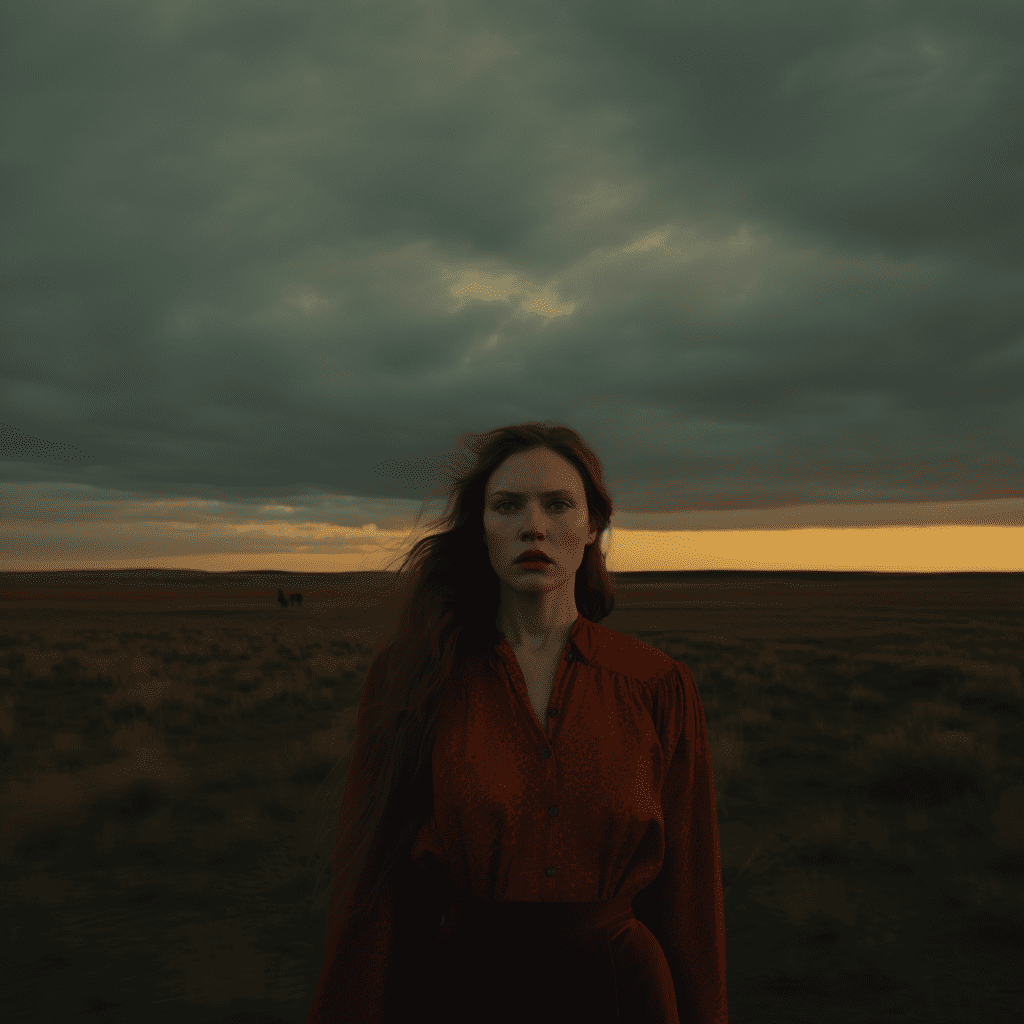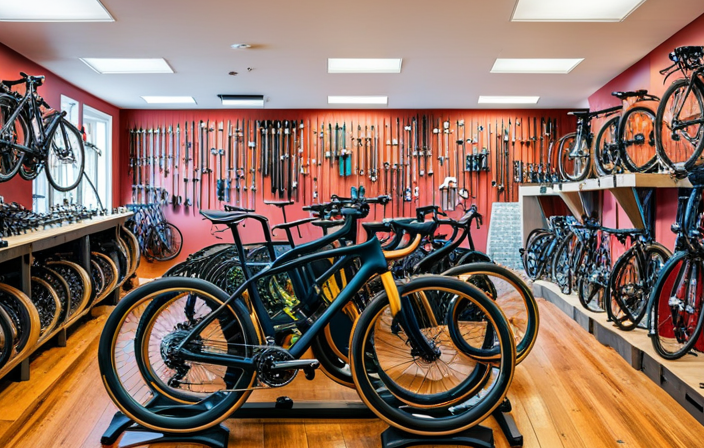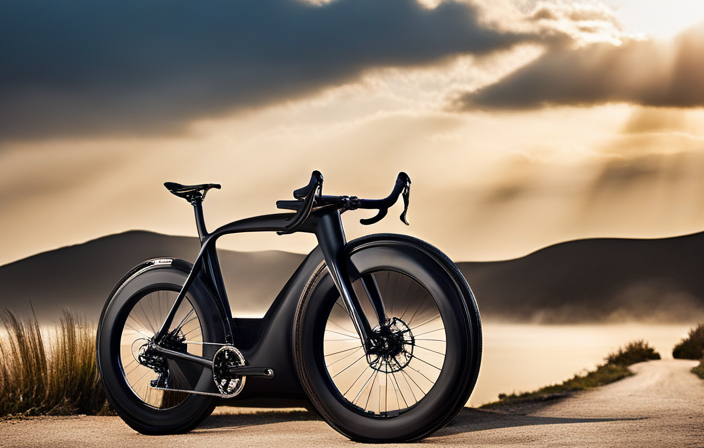Picture the excitement of cycling through wild scenery, overcoming rough terrain and gravel paths effortlessly. That’s the essence of a gravel bike: to unleash your adventurous side and venture off the beaten track.
With its versatile design and ability to handle various surfaces, a gravel bike offers a comfortable and stable riding experience. It allows for wider tires, ensuring enhanced traction and control while maintaining a lightweight and agile frame.
Whether you’re commuting or seeking adrenaline-fueled adventures, join the growing community of gravel biking enthusiasts and embark on unforgettable journeys.
Key Takeaways
- Gravel bikes are versatile and can handle different surfaces, making them suitable for both paved roads and off-road trails.
- They prioritize comfort over speed and provide stability and control at higher speeds, making them ideal for long-distance rides and endurance riding.
- Gravel bikes are popular among bikepackers and touring enthusiasts due to their ability to handle mixed terrain and provide a comfortable and stable riding experience for multi-day trips.
- They offer all-weather performance with features such as wider tires for increased grip on slippery surfaces, specific geometry for stability, corrosion-resistant frames, and reliable stopping power with disc brakes in wet or muddy conditions.
Versatility for Various Terrains
If you’re looking for a bike that can handle various terrains, a gravel bike is perfect for you. Gravel bikes are designed to be versatile and capable of tackling different types of surfaces, making them the ideal choice for riders who want to explore both paved roads and off-road trails. One of the main advantages of a gravel bike is its suitability for racing on gravel roads. These bikes are equipped with wider tires that provide better traction and stability, allowing riders to navigate through loose gravel and uneven surfaces with ease.
Additionally, gravel bikes are also popular among bikepackers who enjoy long-distance adventures on mixed terrain. Gravel bikes offer a comfortable and stable riding experience, thanks to their unique design features. They typically have a more relaxed geometry compared to road bikes, which allows for a more upright riding position that reduces strain on the back and neck. The wider tires absorb vibrations from rough surfaces, providing a smoother ride even on bumpy terrain. This combination of comfort and stability makes gravel bikes suitable for long rides or multi-day bikepacking trips.
With their versatility and ability to handle various terrains, gravel bikes are an excellent choice for riders who want to explore beyond traditional road cycling. Whether you’re interested in racing on gravel or embarking on epic bikepacking adventures, a gravel bike will provide the performance and comfort you need to tackle any type of terrain with confidence.
Comfortable and Stable Riding Experience
Designed for a smooth and secure ride, gravel bikes offer a comfortable and stable experience on various terrains. These bikes are designed to prioritize comfort over speed, making them perfect for those who enjoy leisurely rides or long-distance adventures. With their relaxed geometry and wider tires, they absorb bumps and vibrations more effectively than road bikes, providing a smoother ride even on rough surfaces. This makes gravel bikes suitable for all skill levels, from beginners to experienced riders.
To illustrate the comfort provided by gravel bikes, consider the following table:
| Comfort Features | Benefits |
|---|---|
| Relaxed Geometry | Offers an upright riding position that reduces strain on the back and neck. |
| Wider Tires | Provides better traction and stability on uneven terrain. Also absorbs shocks from bumps and potholes. |
| Disc Brakes | Ensures reliable stopping power in all weather conditions. |
The combination of these features creates a comfortable and enjoyable riding experience that encourages riders to explore different terrains with confidence.
Gravel bikes also excel in stability due to their wider tires and lower center of gravity compared to road bikes. This stability allows riders to navigate corners with ease while maintaining control at higher speeds.
With their ability to handle rough roads and gravel trails, gravel bikes provide a seamless transition towards exploring more adventurous routes without compromising comfort or stability.
Ability to Handle Rough Roads and Gravel Trails
When riding on rough roads and gravel trails, you’ll appreciate the ability of these bikes to handle any terrain. Gravel bikes are specifically designed to provide a smooth and enjoyable experience even when faced with challenging conditions such as rough pavement or gravel bike races. Here are three reasons why they excel in handling these situations:
-
Enhanced Stability: Gravel bikes feature a longer wheelbase and slacker head tube angle, which provides greater stability when navigating uneven surfaces. This ensures that you can confidently maneuver through gravel trails without compromising control.
-
Durable Frames: These bikes are constructed with robust materials like steel or carbon fiber, making them more resistant to the impact of rough terrains. The frames are designed to absorb vibrations and shocks, minimizing discomfort during long rides on bumpy roads.
-
Wider Tires: Gravel bikes typically have wider tires that offer increased traction and grip on loose surfaces like gravel or dirt paths. The larger volume of air in the tires also acts as a natural suspension system, providing additional comfort while tackling rugged terrains.
As we transition into the next section about ‘increased tire clearance for wider tires,’ it’s important to note that this feature further enhances the bike’s ability to handle rough roads and gravel trails without sacrificing performance or control in any way.
Increased Tire Clearance for Wider Tires
One advantage of increased tire clearance for wider tires is that it allows for better traction and control on rough terrain. When riding a gravel bike, having wider tires provides increased stability, especially when encountering loose gravel or uneven surfaces. The larger contact patch between the tire and the ground distributes weight more evenly, resulting in improved traction. This means that even when riding over bumpy roads or gravel trails, the bike is less likely to slide or lose control.
The ability to fit wider tires on a gravel bike also allows riders to adjust their tire pressure according to the terrain they are navigating. Lowering the tire pressure creates a larger footprint, which enhances traction even further by conforming to the irregularities of the road or trail surface. This adaptability ensures that whether you’re tackling steep climbs, descending tricky descents, or maneuvering through technical sections, your gravel bike will provide optimal grip and control.
By enabling riders with increased stability and improved traction, gravel bikes with wider tire clearance offer confidence and peace of mind on challenging terrains. As we move into discussing enhanced traction and control in our subsequent section, it becomes clear how these factors contribute to an overall enjoyable riding experience on a gravel bike without compromising performance or safety.
Enhanced Traction and Control
Having wider tires on a gravel bike allows for enhanced traction and control, resulting in a more enjoyable riding experience. The increased tire width provides improved stability on uneven surfaces, making it easier to navigate through rough terrains. Additionally, the wider tires offer increased grip on loose gravel or dirt roads, reducing the chances of slipping and sliding while riding.
To further understand the benefits of enhanced traction and control, let’s take a closer look at two key aspects:
-
Stability: With wider tires, a gravel bike has a larger contact patch with the ground. This means that there is more surface area in contact with the road or trail, resulting in better stability. It allows riders to confidently tackle challenging terrain without worrying about losing balance.
-
Grip: The wider tires provide increased grip by creating more friction between the tire and the ground. This helps prevent skidding or sliding when cornering or braking, especially on loose surfaces. Riders can maintain better control over their bike even in unpredictable conditions.
With improved stability and increased grip offered by wider tires, gravel bikes are suitable for long distance and endurance riding as well. Transitioning into this next section…
Suitable for Long Distance and Endurance Riding
Gravel bikes with wider tires are ideal for long distance and endurance riding due to their enhanced stability and grip. These bikes are specifically designed to handle a variety of terrains, making them suitable for gravel racing as well. The wide tires provide a larger contact patch with the ground, resulting in improved traction and control. This is especially beneficial when riding over uneven surfaces or loose gravel, as it allows riders to maintain better balance and maneuverability.
Additionally, the endurance-focused geometry of gravel bikes ensures a more comfortable riding position for long hours in the saddle. The frame design offers a more relaxed posture, reducing strain on the back and neck muscles. This makes it easier to sustain a steady pace over extended distances without experiencing excessive fatigue.
Moreover, choosing a gravel bike for long distance rides can significantly benefit cardiovascular fitness. Endurance riding requires sustained effort over extended periods of time, which helps improve heart health and lung capacity. It also provides an excellent opportunity for aerobic exercise that burns calories and contributes to weight management.
Overall, gravel bikes are not only suitable for long distance riding but also offer various benefits such as enhanced traction, stability, and cardiovascular fitness. With their versatility and durability, these bikes open up new possibilities for exploring new routes and embarking on off-road adventures seamlessly into the subsequent section about ‘great for exploring new routes and off-road adventures.’
Great for Exploring New Routes and Off-Road Adventures
If you’re looking to explore new routes and go on off-road adventures, a gravel bike is perfect for you.
With its versatile design and rugged capabilities, a gravel bike allows you to venture beyond the paved roads and delve into uncharted territories.
Here are five reasons why a gravel bike is great for exploring new routes and off-road adventures:
-
All-Terrain Performance: The wide tires and sturdy frame of a gravel bike provide excellent traction and stability on various surfaces, from gravel paths to muddy trails. You can confidently navigate rough terrains without sacrificing speed or control.
-
Adventure-ready Features: Gravel bikes often come equipped with features like disc brakes for reliable stopping power, mounts for attaching racks or bags, and wider gear ratios to tackle steep inclines. These elements make it easier to carry supplies and gear while embarking on longer journeys.
-
Comfortable Riding Position: The relaxed geometry of a gravel bike ensures a comfortable riding position that minimizes strain on your body during long rides. This allows you to fully enjoy the exploration without feeling fatigued too quickly.
-
Increased Stability: Compared to traditional road bikes, gravel bikes offer enhanced stability due to their wider tires and lower center of gravity. This stability is particularly beneficial when riding over loose surfaces or tackling technical trails.
-
Versatility: A gravel bike’s ability to handle both pavement and off-road terrain opens up countless possibilities for exploration. Whether you want to discover hidden mountain trails or take the scenic route through countryside lanes, a gravel bike can adapt effortlessly.
With its capability for adventure, a gravel bike is also ideal for bikepacking and touring—perfectly suited for those seeking memorable experiences on two wheels.
Ideal for Bikepacking and Touring
When you’re planning a bikepacking or touring trip, a gravel bike is the perfect companion to help you have an unforgettable adventure on two wheels. With its versatile design and sturdy construction, a gravel bike is built to handle long-distance rides on various terrains, making it ideal for those looking to explore the world at their own pace.
One of the key advantages of using a gravel bike for bikepacking and touring is its ability to carry all your essential gear. These bikes are equipped with racks and mounts that allow you to attach panniers, bags, and other equipment needed for your journey. This ensures that you have enough storage space for clothes, food, camping gear, and any other necessities.
Additionally, gravel bikes are designed to handle different types of terrain, including paved roads, dirt paths, and even rough trails. This makes them suitable for tackling various touring routes that may involve both on-road and off-road sections. Whether you’re cycling through scenic countryside or exploring remote wilderness areas, a gravel bike can handle it all.
Incorporating keywords: When planning a bikepacking or touring trip with a gravel bike as your trusty companion, having the right bikepacking gear and choosing suitable touring routes is crucial for an enjoyable experience.
Transitioning into the next section about ‘all-weather performance’: Furthermore, not only does a gravel bike excel in providing comfort and versatility during long-distance adventures but its all-weather performance also sets it apart from other types of bicycles.
All-Weather Performance
For an unforgettable adventure on two wheels, you’ll appreciate how a gravel bike’s all-weather performance sets it apart from other types of bicycles. Whether you’re riding in rain, snow, or muddy conditions, this versatile machine is designed to handle it all with ease.
Here are some key features that make a gravel bike perfect for all-weather riding:
-
Increased Grip: Gravel bikes typically come equipped with wider tires that offer better traction on slippery surfaces. This means you can confidently tackle wet roads or muddy trails without worrying about losing control.
-
Better Handling: The geometry of a gravel bike is specifically designed to provide stability and control on uneven terrain. With a longer wheelbase and slacker head tube angle, these bikes offer a smoother ride and improved handling when navigating through challenging weather conditions.
-
Durable Components: Gravel bikes are built to withstand the elements. From corrosion-resistant frames to sealed bearings, every component is chosen to ensure long-lasting performance in any weather condition.
-
Disc Brakes: Most gravel bikes feature disc brakes which provide reliable stopping power even in wet or muddy conditions. This gives you peace of mind knowing that you can stop quickly and safely when needed.
With its increased grip and better handling capabilities, a gravel bike allows riders to confidently take on any weather condition. But that’s not all – these bikes are also compatible with accessories and gear that enhance your riding experience. Transitioning into the next section about compatibility with accessories and gear…
Compatible with Accessories and Gear
You’ll love how easily you can personalize and enhance your riding experience with the wide range of accessories and gear that are compatible with a gravel bike. Whether you’re a novice rider or an experienced cyclist, having the right accessories can make all the difference in your enjoyment and comfort on the road. From cargo racks to fenders, there’s no shortage of options when it comes to customizing your gravel bike.
One of the key advantages of gravel bikes is their compatibility with various accessories. The table below showcases some common accessories and gear that can be easily mounted onto a gravel bike:
| Accessory/Gear | Description | Benefits |
|---|---|---|
| Cargo Rack | Provides extra storage for long rides | Carry essentials without weighing down your back |
| Fenders | Keeps mud and water off your clothes | Stay clean and dry regardless of weather conditions |
| Lights | Enhances visibility during night rides | Ride safely even in low light |
Having these compatible options at your disposal allows you to tailor your ride to meet specific needs or preferences. Now, let’s delve into how a gravel bike’s compatibility with these accessories also leads to lower maintenance requirements…
Lower Maintenance Requirements
The lower maintenance requirements of a gravel bike make it an ideal choice for riders seeking convenience and ease. One of the key advantages of gravel bikes is their cost-effective maintenance. Unlike road bikes, which often require expensive specialized components and regular tune-ups, gravel bikes are designed to withstand rough terrain and can handle a variety of conditions without excessive wear and tear on their parts. This means that not only is the initial investment in a gravel bike more affordable than other types of bicycles, but the ongoing upkeep costs are also minimized.
In addition to being cost-effective, gravel bikes have minimal upkeep requirements. The robust construction of these bikes ensures that they can handle the rigors of off-road riding without frequent adjustments or repairs. The frames are typically made from durable materials such as aluminum or carbon fiber, which are resistant to corrosion and damage. The drivetrains are designed to be reliable and low-maintenance, with sealed components that require little attention beyond occasional cleaning and lubrication.
With their lower maintenance needs, gravel bikes allow riders to spend less time tinkering with their bicycles and more time enjoying the ride. In the next section, we will explore another benefit of these versatile machines: their more upright riding position for better visibility on the road ahead.
More Upright Riding Position for Better Visibility
Another advantage of gravel bikes is that they provide a more upright riding position, allowing for better visibility on the road ahead. This upright riding position has several benefits:
-
Enhanced awareness: When you ride in an upright position, your field of vision expands, enabling you to see further down the road and anticipate any potential obstacles or hazards. Whether it’s a pothole, a parked car, or pedestrians crossing the street, being able to spot these things early on gives you more time to react and make informed decisions.
-
Improved safety: With better visibility comes increased safety. Being able to see and be seen by other motorists is crucial when navigating through traffic or busy intersections. The higher riding position of gravel bikes ensures that you are more visible to drivers, reducing the risk of accidents caused by blind spots.
-
Comfortable and ergonomic: Riding with an upright posture reduces strain on your neck, shoulders, and lower back. It promotes a natural alignment of your spine and allows for proper weight distribution between your saddle and handlebars. This not only makes longer rides more enjoyable but also minimizes the risk of fatigue or discomfort during your cycling adventures.
Transitioning into the subsequent section about lightweight and agile design…
Lightweight and Agile Design
Get ready to experience the benefits of a lightweight and agile design that enhances your cycling performance. Gravel bikes are specifically designed to provide exceptional uphill performance and precise downhill control. The lightweight construction allows for easier maneuverability, making it effortless to navigate through tight corners or technical terrains.
When tackling steep inclines, the gravel bike’s lightness plays a crucial role in maintaining speed and conserving energy. It allows you to effortlessly conquer challenging climbs without feeling weighed down by a heavy bike. This is especially beneficial during long rides or endurance races when every ounce matters.
Moreover, the agile design of gravel bikes ensures superior control while descending. The responsive handling enables quick adjustments, providing riders with confidence and stability as they tackle rapid descents or tricky obstacles on off-road trails. This level of control not only enhances safety but also improves overall riding experience.
With their combination of uphill performance and downhill control capabilities, gravel bikes have become a popular choice for commuting and urban riding as well. Transitioning from off-road adventures to city streets is seamless with these versatile machines.
So get ready to embrace the lightweight and agile design of gravel bikes as we dive into why they are also a popular choice for commuting and urban riding!
Popular Choice for Commuting and Urban Riding
Transitioning from off-road adventures to city streets is a breeze with the versatility of gravel bikes, making them a popular choice for commuting and urban riding. The benefits of using a gravel bike for commuting are numerous. Firstly, the wider tires and sturdy frame provide stability and comfort on uneven surfaces, such as potholes or cobblestones, which are commonly found in urban environments. This ensures a smoother ride and reduces the risk of flat tires. Additionally, the relaxed geometry of gravel bikes allows for an upright riding position that offers better visibility in busy city traffic.
In terms of urban riding advantages, gravel bikes excel due to their ability to handle different terrains effortlessly. Whether it’s navigating through congested streets or taking shortcuts through parks or trails, these bikes can easily adapt to various conditions without compromising speed or agility. Furthermore, many gravel bikes come equipped with mounts for racks and fenders, allowing commuters to carry groceries or essentials while keeping themselves dry during wet weather.
As more individuals discover the convenience and versatility of these bikes for commuting and urban riding, a growing community has formed around gravel biking enthusiasts. This has led to an increase in organized events such as group rides and races specifically tailored for this type of cycling discipline. Transitioning from discussing the benefits of gravel biking for commuting and urban riding into exploring this thriving community brings insight into the social aspect that accompanies this sport.
Growing Community and Events for Gravel Biking Enthusiasts
With the rising popularity of gravel biking, enthusiasts are coming together to organize events and build a strong community. Community building has become an integral part of the gravel biking experience, as riders seek to connect with fellow enthusiasts and share their passion for this versatile and adventurous sport.
One way in which the gravel biking community is growing is through the organization of gravel bike races. These races attract riders from all skill levels and provide an opportunity for participants to challenge themselves on various terrains. From smooth dirt roads to rocky trails, these races test riders’ endurance, technical skills, and navigation abilities.
Gravel bike races come in different formats, including timed events or self-supported rides where participants must navigate a predetermined route with minimal support. These races not only offer a chance for riders to compete but also serve as social gatherings where like-minded individuals can come together and celebrate their love for gravel biking.
In addition to organized races, there are also gravel biking events that focus on exploration and camaraderie rather than competition. These events often involve group rides where participants can explore new routes or take on challenging terrain together. Such events foster a sense of inclusivity and encourage riders of all abilities to join in the fun.
Overall, the growing community and events for gravel biking enthusiasts have contributed greatly to the increasing popularity of this sport. Whether it’s through organized races or casual group rides, these activities allow riders to connect with others who share their passion while pushing themselves further on their beloved gravel bikes.
Frequently Asked Questions
Are gravel bikes suitable for road cycling or are they only meant for off-road riding?
Gravel bikes are versatile and can be suitable for both road cycling and off-road riding. They are designed to handle different terrains, making them a great choice for commuting or long-distance riding.
On roads, they offer the speed and efficiency of a road bike with wider tires for added stability. Off-road, they provide the durability and traction needed to tackle gravel paths and rough trails.
Whether it’s your daily commute or an adventurous ride, a gravel bike is a reliable option.
Can a gravel bike be used for racing or is it primarily designed for leisure riding?
Gravel bikes are not just for leisurely rides; they can also be used for racing. In fact, gravel bike racing has gained popularity in recent years.
The advantage of using a gravel bike for racing is its versatility. These bikes are designed to handle both on and off-road terrain, making them perfect for long distance rides that may include various surfaces.
So, if you’re looking for a thrilling and challenging race experience, a gravel bike could be your best bet!
How does the tire clearance of a gravel bike affect its performance on different terrains?
The tire clearance of a gravel bike greatly affects its performance on different terrains. With wider tire clearance, you can run lower tire pressure, which increases traction and comfort on rough surfaces. This allows the bike to smoothly navigate through gravel, dirt, and even muddy sections.
Additionally, the tread pattern on the tires plays a crucial role in providing grip and control. A more aggressive tread pattern is ideal for loose or wet terrain, while a smoother tread performs better on hard-packed surfaces.
What are some popular accessories and gear that can be used with a gravel bike?
When it comes to gravel biking, there are a variety of accessories and essential gear that can enhance your riding experience.
Some popular gravel bike accessories include handlebar bags, frame bags, and top tube bags for carrying essentials like tools, snacks, and water bottles.
Additionally, fenders can be helpful in keeping mud and debris off you and your bike.
Other essential gear includes a helmet, gloves for grip and protection, and sunglasses for eye protection.
How does the maintenance of a gravel bike compare to that of a regular road bike or mountain bike?
The maintenance of a gravel bike is similar to that of a regular road bike or mountain bike, but there are a few key differences.
Gravel bikes require more frequent cleaning due to the dirt and debris they encounter on off-road surfaces. Additionally, the tires may wear faster and need more frequent replacement.
However, other components like brakes, drivetrain, and suspension require similar maintenance as their counterparts on road or mountain bikes.
Overall, proper maintenance is essential for optimal performance and longevity.
Conclusion
In conclusion, gravel bikes have become increasingly popular due to their versatility and ability to handle various terrains. Whether you’re exploring rough roads or tackling gravel trails, these bikes offer a comfortable and stable riding experience.
With increased tire clearance for wider tires, enhanced traction and control are also guaranteed. Furthermore, the more upright riding position provides better visibility while the lightweight and agile design make them ideal for commuting and urban riding.
Just imagine cruising through the countryside on your gravel bike, feeling the wind in your hair as you navigate through scenic routes – it’s an adventure waiting to happen!
